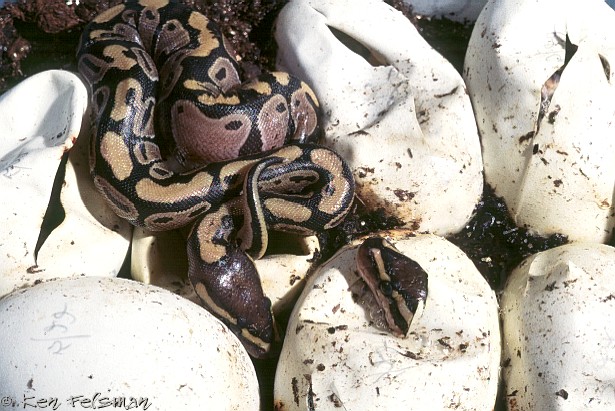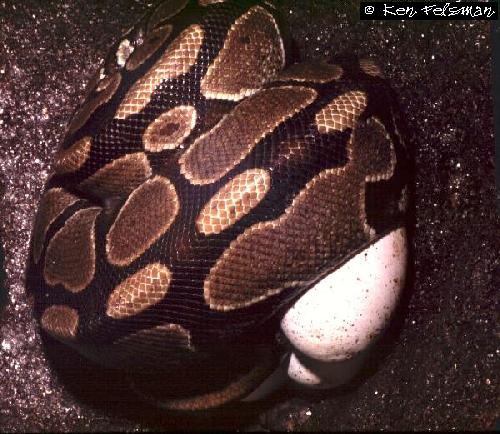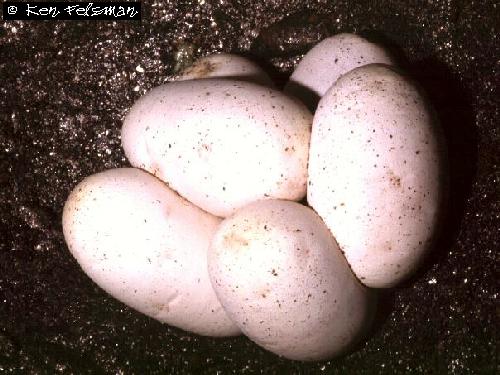
Troubleshooting Guide to BALL PYTHONS |  |
Tips for Successful Breeding
 After some experience caring for Ball Pythons, I would encourage anyone interested to try and breed them. They are becoming more and more scarce in the wild, and the fewer Ball Pythons that have to be imported from the wild the better.
After some experience caring for Ball Pythons, I would encourage anyone interested to try and breed them. They are becoming more and more scarce in the wild, and the fewer Ball Pythons that have to be imported from the wild the better.
One of the first things you will need to do is identify what gender your snake is and make sure you have a mate. Generally males will have thicker tails, and the anal spurs will be more curved. Probe depths are about 2-4 subcaudal scales for female Ball Pythons, and 6-10 for males. It is better to have a group of three or more snakes with at least two males. The males will combat a little, and to the victor go the spoils.
The breeding process is a year long cycle. During the spring, summer, and early fall, my snakes are housed separately, kept at optimal temperatures, and fed every two or three weeks. In about October or November, I stop feeding the snakes and leave them at regular temperatures. After a few weeks without food, I move my two males and three female adults together into a 60 Gallon aquarium (30x18x18 inches). The tank has three hide boxes, one of which acts as the water bowl. I provide regular temps in the high 80's during the day and until about 2:00am. At 2:00am, I turn off the lights and let the temperature drop into the low 70's or even high 60's. The light comes back on at 11:00am and warms things back up. Some breeders have had success offering 12 hours of light and 12 of dark, but mine seem to do OK. I continue to offer food to the females every three or four weeks, but I expect that they will choose not to eat. Some breeders have also suggested providing more humidity during the mating season, but again mine seem to do fine without worrying about that factor.
 Around March or April, I separate the snakes back out to their respective individual tanks and resume regular temperature and light cycles. During the spring I try and feed the females pretty heavily. If they happen to become gravid (pregnant) they will begin to refuse food. You may notice the females having some swelling and basking with their bellies turned up. They usually go into a shed cycle and lay six to seven eggs a week or two after the shed. I provide a warm lay box with a damp mixture of sphagnum based peat moss and vermiculite. Laying usually happens at night, and the females stay coiled around the clutch of eggs. Separating the female from the eggs and incubating them is usually a better way to ensure the eggs hatch. I separate the eggs from each other as much as I can and place them in a tupperware with the peat/vermiculite mixture. Being in the midwest has it's advantages in that our local farm supply (Farm & Fleet) sells Hovabator brand incubators for about $30. After about sixty days of incubating at 88-90F, you should see heads pip from the eggs. Usually the whole clutch will pop heads out within about 24 hours of each other. At this point, I remove the tupperware from the incubator and place it into a warm ten gallon tank. Typically within 24-48 hour of pipping the baby snakes have absorbed the egg yolk, and decide to fully emerge from the egg. A week or ten days later the babies will have their first slough. A week or so after the shed you should start trying to get them to eat.
Around March or April, I separate the snakes back out to their respective individual tanks and resume regular temperature and light cycles. During the spring I try and feed the females pretty heavily. If they happen to become gravid (pregnant) they will begin to refuse food. You may notice the females having some swelling and basking with their bellies turned up. They usually go into a shed cycle and lay six to seven eggs a week or two after the shed. I provide a warm lay box with a damp mixture of sphagnum based peat moss and vermiculite. Laying usually happens at night, and the females stay coiled around the clutch of eggs. Separating the female from the eggs and incubating them is usually a better way to ensure the eggs hatch. I separate the eggs from each other as much as I can and place them in a tupperware with the peat/vermiculite mixture. Being in the midwest has it's advantages in that our local farm supply (Farm & Fleet) sells Hovabator brand incubators for about $30. After about sixty days of incubating at 88-90F, you should see heads pip from the eggs. Usually the whole clutch will pop heads out within about 24 hours of each other. At this point, I remove the tupperware from the incubator and place it into a warm ten gallon tank. Typically within 24-48 hour of pipping the baby snakes have absorbed the egg yolk, and decide to fully emerge from the egg. A week or ten days later the babies will have their first slough. A week or so after the shed you should start trying to get them to eat.
|
Sponsored Link
Recent Ball Pythons Forum Posts
• Is This Enough Airflow?, posted by BelatedBoa
• Can’t find extremely rare morph: normal, posted by breitenup
• Sick Python, posted by pandalumps
• Introducing New Morph, the "Nguyen", posted by KNreptile
• Picture Request, posted by zippy00_99
• Mystic VS Mojave, posted by alchemyreptiles
• Ball Python Eggs ????, posted by mingdurga
• Wrinkly baby ball, posted by jmsandlin
• 6 y.o male hypo, het albino - San Diego, posted by zraverherp
• Opinions please on these snakes..., posted by ArmorofGod
• Female Lemon Blast Spider Ball Python, posted by Northwest
• Super banana spider, posted by jerryruiz510
• Stressed? (Change in behavior), posted by MessickMe
• ball python acting strangely, posted by jmsandlin
• White Diamond, posted by RichardHurtz
• Help with Bamboo Vanilla Ghost clutch, posted by Chad_Ramsey
• New Owner . . . soon, posted by Leah844
• Ball Python, posted by alexisstar
• How to maintain humidity?, posted by HiddenMe
• Eating problems, posted by Pythons1233
Recent Ball Python Classifieds:
- Ghost Het Pied
- Albino Het Pieds
- Proven Adult Female Moja...
- Adult Female Pastel Clow...
- Butter Pastel Het Hypo H...
- Killer Pied
- Lesser Calico Shatter He...
- For Sale Pastel Lesser H...
- SALE Albino Het Pieds
- Albino Clown
- Pastel Puma
- Killer Pied
- Albino Het Genetic Strip...
- Albino Mojave
- Pinstripe Het Ghost Het ...
Banner Pool
|





 After some experience caring for Ball Pythons, I would encourage anyone interested to try and breed them. They are becoming more and more scarce in the wild, and the fewer Ball Pythons that have to be imported from the wild the better.
After some experience caring for Ball Pythons, I would encourage anyone interested to try and breed them. They are becoming more and more scarce in the wild, and the fewer Ball Pythons that have to be imported from the wild the better.
 Around March or April, I separate the snakes back out to their respective individual tanks and resume regular temperature and light cycles. During the spring I try and feed the females pretty heavily. If they happen to become gravid (pregnant) they will begin to refuse food. You may notice the females having some swelling and basking with their bellies turned up. They usually go into a shed cycle and lay six to seven eggs a week or two after the shed. I provide a warm lay box with a damp mixture of sphagnum based peat moss and vermiculite. Laying usually happens at night, and the females stay coiled around the clutch of eggs. Separating the female from the eggs and incubating them is usually a better way to ensure the eggs hatch. I separate the eggs from each other as much as I can and place them in a tupperware with the peat/vermiculite mixture. Being in the midwest has it's advantages in that our local farm supply (Farm & Fleet) sells Hovabator brand incubators for about $30. After about sixty days of incubating at 88-90F, you should see heads pip from the eggs. Usually the whole clutch will pop heads out within about 24 hours of each other. At this point, I remove the tupperware from the incubator and place it into a warm ten gallon tank. Typically within 24-48 hour of pipping the baby snakes have absorbed the egg yolk, and decide to fully emerge from the egg. A week or ten days later the babies will have their first slough. A week or so after the shed you should start trying to get them to eat.
Around March or April, I separate the snakes back out to their respective individual tanks and resume regular temperature and light cycles. During the spring I try and feed the females pretty heavily. If they happen to become gravid (pregnant) they will begin to refuse food. You may notice the females having some swelling and basking with their bellies turned up. They usually go into a shed cycle and lay six to seven eggs a week or two after the shed. I provide a warm lay box with a damp mixture of sphagnum based peat moss and vermiculite. Laying usually happens at night, and the females stay coiled around the clutch of eggs. Separating the female from the eggs and incubating them is usually a better way to ensure the eggs hatch. I separate the eggs from each other as much as I can and place them in a tupperware with the peat/vermiculite mixture. Being in the midwest has it's advantages in that our local farm supply (Farm & Fleet) sells Hovabator brand incubators for about $30. After about sixty days of incubating at 88-90F, you should see heads pip from the eggs. Usually the whole clutch will pop heads out within about 24 hours of each other. At this point, I remove the tupperware from the incubator and place it into a warm ten gallon tank. Typically within 24-48 hour of pipping the baby snakes have absorbed the egg yolk, and decide to fully emerge from the egg. A week or ten days later the babies will have their first slough. A week or so after the shed you should start trying to get them to eat.


.jpg)

